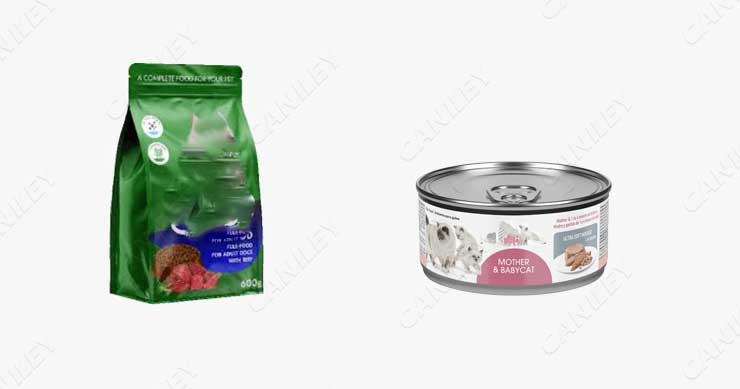As more and more families start to keep pets, the demand for pet food is gradually increasing. In order to make pet food packaging more suitable for home use, manufacturers are constantly trying various pet food packaging types. Commonly used packaging types are bags and cans.

- Bag packaging
Depending on the type of bag used, it can be divided into the following categories:
Bag seal bag: Compared with other packaging types, the back-sealed bag has no edge sealing on both sides of the bag body, so the pattern on the front of the package is guaranteed to be complete and more beautiful. At the same time, in the typesetting design, the bag pattern can be designed as a whole, which can maintain the continuity of the picture. And the seal is on the back, so the sides of the bag can withstand more pressure, reducing the possibility of package damage.
Stand up pouch: It can increase the shelf display function and is convenient for users to use. It is a relatively novel packaging method. You can also choose to use zipper stand-up pouches, which can be sealed repeatedly to extend the shelf life of pet food.
Box pouch:
The scope of application of this packaging method is similar to that of the stand-up pouch, except for the difference in the style of the bag. Compared to the stand-up bag, this bag style is more beautiful and more expensive.
2. Cans packaging
This is another more commonly used types of packaging. The pet food is filled and sealed after the cans are filled. It is more convenient for transportation and reduces the loss during transportation. But it takes up a lot of space.
More and more customers are championing to improve the sustainability of the packaging they use, and often they jump on the bandwagon of new material trends, or shift suppliers to offer packaging alternatives that are not actually suitable for their products. Manufacturers should consider fit, safety, appearance, and market demand when choosing a packaging type.
But regardless of the packaging method, the final pet food packaging must serve its purpose—It needs to protect the pet food inside and there are a few key factors that cannot be overlooked, most importantly shelf life product and shipping requirements.
Related products:
